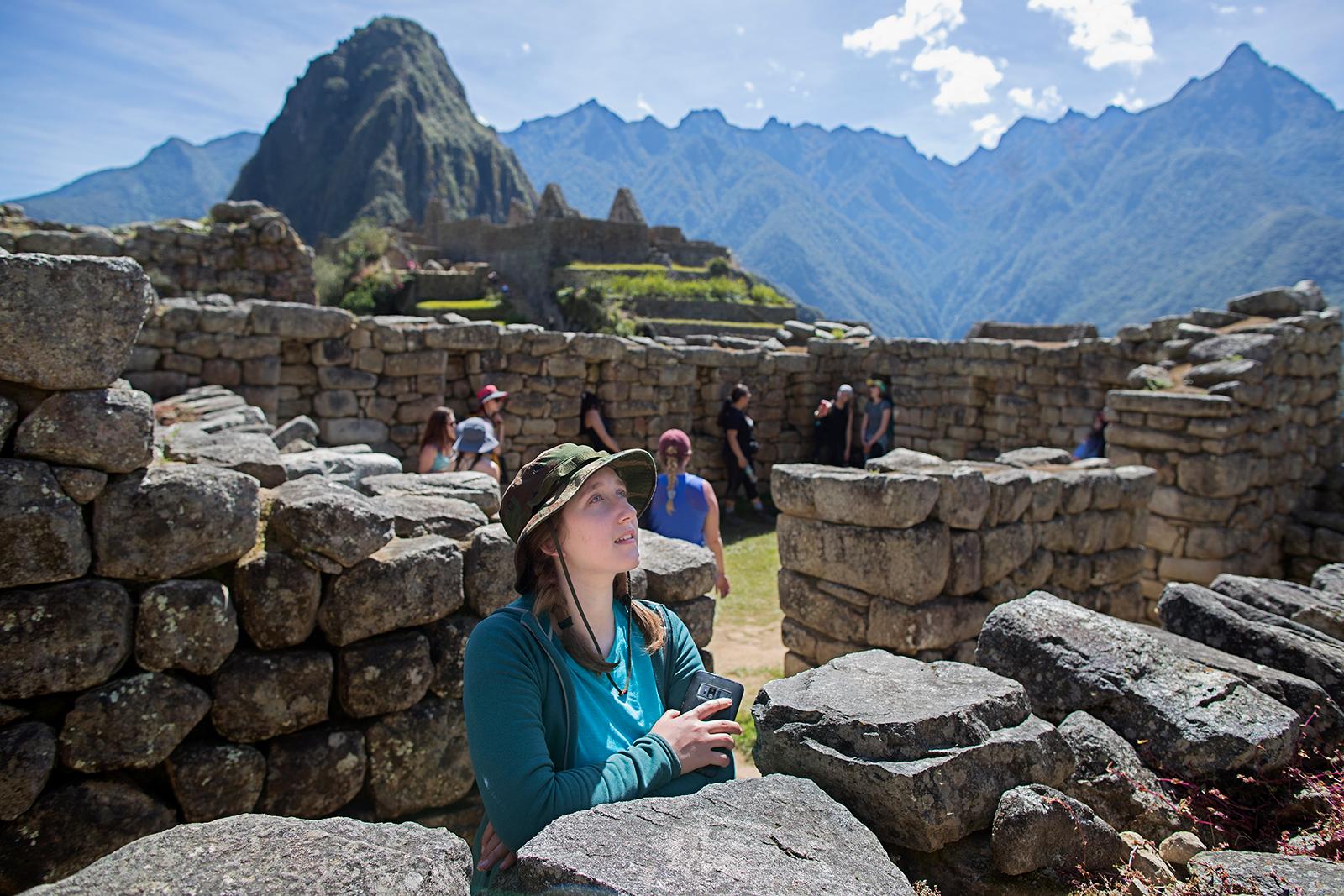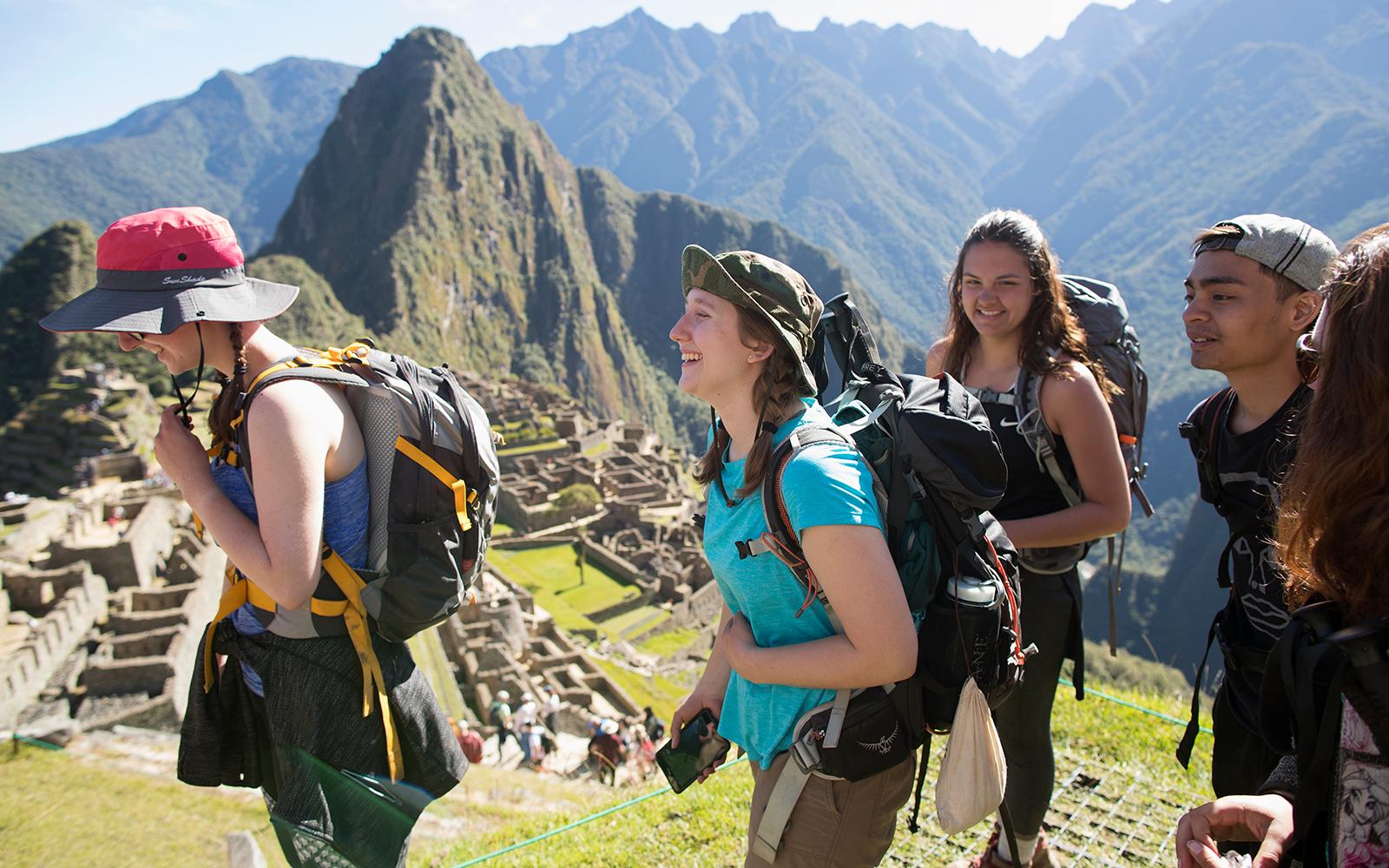Surrounded on all sides by the meticulous stonework of the Incas, Alanna Pinard-Brace ’19 & ’20 leans on an ancient wall in Machu Picchu, eyes scanning from side to side, as she examines the nuances of the ruins and the roughly 200 structures that make up the UNESCO world heritage site. After a strenuous seven-day backpacking trip, she had arrived at the famous city sitting high in the Andes above the Urubamba River valley.

“I’ve done three different trips with the Crane Chorus or Concert Choir. We’ve gone to Spain and walked part of the Camino de Santiago. Last summer, we went to Germany and biked along the Elbe River, and we just hiked the Salkantay and Inca trails to Machu Picchu. Those are the kinds of travel experiences that I’ve had through Crane,” Pinard-Brace said.
The epic journey was the perfect opportunity to experience another culture after just graduating with her bachelor’s degree in music education and before starting her master’s program in the same field this fall. The trek through Peru proved to be the most demanding experience of her life as she hiked over rocky terrain, climbed to high altitude mountain passes and slept below snow covered-peaks, en route to Machu Picchu with other students from The Crane School of Music.
“In the beginning, it’s hard and it creates challenges for you. You think you can’t do it. But every day you make it to the camp, or you make it to the top of that mountain. You pick yourself up and you get there. My thinking shifted partway through the trip, from ‘I can’t do it, this is so hard,’ to ‘I just need to take it one step at a time and I’m going to get there’—which I think is a really good lesson to learn and a good thing to take away from this trip,” she said.

When she first arrived in Peru, Pinard-Brace and her classmates visited a cultural center in the city of Calca, to learn about traditional Andean music. They wore traditional clothing, played instruments and sang around an open fire. “We spent two days learning about Andean culture and learning how to play different Andean musical instruments like the panflute, which I found very interesting because music is such a passion of mine,” she said. “I really enjoyed learning about the cultural aspects of the music and how the instruments connect to different things in nature—a really cool way to start out this trip, considering that we were doing so much hiking in the mountains.”
Now back in the U.S., Pinard-Brace is gearing up for her graduate program in music education—an expedited one-year master’s degree for students who matriculated through the undergraduate program. “I really enjoyed my time at Potsdam, which is part of why I want to stay. But also, I really enjoy the fact that the master’s program at Crane is very individualized. There are a lot of electives, so you get to personally select the content that you want to learn about,” she said.
“The thing I love most about SUNY Potsdam and The Crane School of Music is that because it’s a smaller campus, you really get to know everybody. It feels like home. You really get to interact with the teachers, and you get a lot of individualized attention as well.”
As a graduate student, Pinard-Brace will be working on her conducting skills and she hopes to explore the intersection between music and world cultures. In addition to Peru, she was previously introduced to world music through her undergraduate work with the Crane West African Drum and Dance Ensemble. The group performed music from Togo and Ghana and students had the opportunity to work with Martin Kwaku Kwaakye Obeng, a master drummer from Ghana. She hopes to continue studying ethnomusicology at the graduate level this fall, and then teach world music to her students when she lands her first job. “It would be good to have that in my back pocket for teaching, because it’s important to expose kids to different cultures at a young age,” she said.
Pinard-Brace already has classroom experience under her belt as a result of completing two student teaching placements her senior year at Crane—the capstone experience for undergraduate students in the music education program. She started at Chittenango High School and then moved to Bolivar Road Elementary School, both in the same district. “I got to teach a variety of music classes. I’m a voice major, so chorus is my main focus, but I didn’t just teach chorus, I taught general music, theory and classroom piano. I also had the chance to help out with the school musical—which was also very interesting, to see that behind the scenes aspect of being a music teacher. It was a really cool experience,” she said.
The road that led her to SUNY Potsdam and the music education program at The Crane School of Music started in high school. “I had really influential teachers in my life and I shifted from music performance to music education. I had a really impactful music teacher, Carl Recchia, at Champlain Valley Union High School in Vermont, and I wanted to be that kind of teacher. I’ve also always liked working with kids,” Pinard-Brace said.
When it came time to choose a college, she worked with her counselor to find the right spot. “When I visited Potsdam, it immediately became my top choice school! Everyone was so friendly and welcoming that it felt like home the minute I was there,” she said.
Four years later, that feeling has only been reinforced. “You form a lot of connections and you get really memorable, useful, individualized experiences when you’re at Potsdam.”
After graduating with her master’s degree in 2020, Pinard-Brace will be looking for a position as an elementary school teacher. “My ultimate teaching goal shifted after student teaching. I thought I wanted to teach high school, but I felt such a connection at my elementary school placement. My teaching philosophy is to create a love of music and make a difference. I feel like I can do that most effectively at the elementary school level,” she said. “The ideal plan is to find an elementary school placement where I can really introduce different music to students and get them excited about learning about different cultures and different styles of music.”
Article and photos by Jason Hunter
